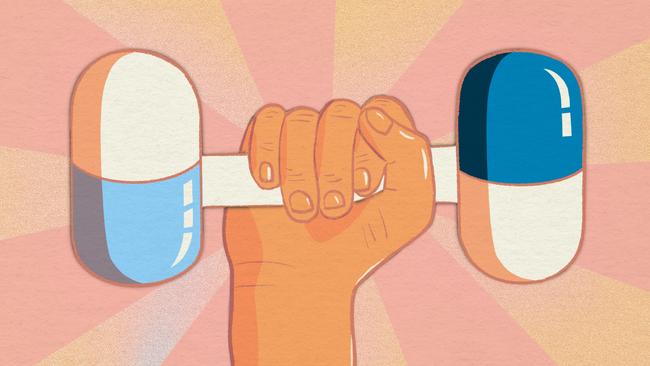Australians seem all too ready to pop pills when lifestyle changes could stop disease in its tracks
Prescription drugs are being doled out with alarming regularity. Dubious surgeries are on the rise. Now there’s a growing push-back against overdiagnosis, overprescription and overtreatment.

It’s a paradox of modern medicine that many of today’s most prevalent health conditions are capable of being fixed by measures other than pharmaceuticals, yet the rate of prescription of drugs is climbing exponentially.
Scripts are doled out with alarming regularity for conditions that are likely to get better simply with the passage of time and circumstance. The tendency towards overtreatment is reflected in high rates of dubious surgeries, too, with tens of thousands of patients every year going under the scalpel for orthopaedic procedures that lack evidence of efficacy and frequently cause harm.
And patients with chronic metabolic diseases often are simply told to pop pills to manage blood sugar and insulin, when dietary interventions have the capacity to reverse diseases such as Type 2 diabetes completely.
“Overall, it has been consistently estimated that around 60 per cent of medical care is effective, 30 per cent is of little or no value and a further 10 per cent is harmful,” says Ian Harris, an orthopaedic surgeon and co-author of the book Hippocrasy: How Doctors are Betraying Their Oath.
“This means that around 40 per cent of what doctors do is overtreatment and overdiagnosis: treatments and tests that don’t actually help people but often cause harm.
“Research has also shown that doctors consistently over-estimate the benefits and underestimate the harms of their interventions. This is a driver of overtreatment and overdiagnosis because when a doctor recommends a treatment or a test, they are basing the recommendation on the balance of benefits and harms, but their estimate of that balance is skewed.”
Around the world there is a growing push-back against what some have labelled the “medico-industrial complex” that drives trends of overdiagnosis, overprescription and overtreatment. Blockbuster antidepressant medications are a major focus, with Britain leading the world in a “deprescribing” movement that aims to educate patients on symptoms that commonly come with withdrawal from psychoactive drugs.
The deprescribing movement is also challenging notions of the degree of efficacy of selective serotonin reuptake inhibitors, or SSRIs, emphasising that alternative interventions such as exercise and psychotherapy are often just as effective as antidepressant drugs, and that the medications are not designed to be taken for years on end.
An astonishing one in seven people in Australia was taking an SSRI in 2021, the latest figures from the Australian Institute of Health and Welfare show. That’s the second highest rate of prescribing in the world.
“I think there is an increasing biomedicalisation of human experience in Western societies,” Victorian psychiatrist William Lugg says. “The old adage of a pill for every ill seems to be quite true. And so we do have a tendency to biomedicalise distress.”
Lugg, a public hospital consultant psychiatrist, is leading a team that is piloting Australia’s first psychotropic medication deprescribing program, working with GPs in Melbourne and a community health service. It’s designed to provide a framework for people to safely taper down their medication, giving them a better understanding of withdrawal symptoms and how to manage them.
“I’m of the view, as is my team, that stopping people’s dependence on these medications is as important as helping people to go on them,” Lugg says.
“I think there’s been a longstanding underappreciation to the degree to which people develop physiological dependence on these drugs.”
There are divergent views among psychiatrists as to the true efficacy of SSRIs, but it seems apparent that in many cases the medication is prescribed inappropriately for mild depression that would resolve on its own or could be addressed effectively through lifestyle and social interventions.

One recent reanalysis published in the journal BMJ Open of a widely cited systematic review found it was “unclear whether antidepressants are more efficacious than placebo”. Other recent studies have indicated exercise may be as effective or even more effective than antidepressant medication.
That’s no surprise to proponents of what has become known as lifestyle medicine, a growing and increasingly organised movement aimed at preventing and treating – through non-pharmaceutical methods – chronic, complex and lifestyle-related conditions including depression and anxiety and other diseases with environmental, societal and behavioural causes such as Type 2 diabetes, obesity and cardiovascular disease.
Treatments under the umbrella of lifestyle medicine include the formal evidence-based application of nutrition, fasting, movement, sleep, mind-body practices including mindfulness, and stress management.
The movement also focuses on reduced substance use and pathological screen use, social connectedness and connection with the natural world. It uses health coaching, new models of care and digital health to prevent and treat disease.
The evidence is growing that such lifestyle approaches should be frontline treatments in chronic disease, but gaining traction is a battle against powerful vested interests that tend to drive medicine’s mainstream emphasis on surgery and drugs.
“I think one of the problems with medicine is that there are such powerful lobby groups that really divert us away from the things that we know are the best, lowest cost interventions – primary care and preventive care,” former deputy chief medical officer Nick Coatsworth says.
This week Coatsworth gave the opening address at the Lifestyle Medicine Better Health for All international conference presented by the Australasian Society of Lifestyle Medicine in Melbourne, where practitioners received high-level training in the application of lifestyle medicine.
ASLM is a not-for-profit organisation working towards improved prevention, management and treatment of chronic, complex and lifestyle-related conditions.
“Everybody knows that primary care and preventive care are where the healthcare dollar needs to go,” Coatsworth says.
“What that means is that you have to be able to take on the medico-industrial complex in a way that no government has done before. I don’t think any government has ever had a serious attempt to exercise the regulatory power to rein in the costs of the medico-industrial complex.”
One of the examples of what Coatsworth calls the medico-industrial complex is the inflated cost of medical devices in Australia. It’s common for medical device sales reps to be in the operating theatre side-by-side the surgeon, ostensibly to deliver education. Critics are alarmed by the practice, which raises significant issues of device company influence on the doctor’s choice of prosthetic and also the potential for unjustified excess use of glues and consumables, which all must be paid for by private health funds.
“No doctor gets an invitation from a pharma company for the box to watch the Wallabies any more, whereas that was happening in the 1990s,” Coatsworth says.
“There has been some curtailing of pharma influence. It’s not clear that the medical device companies are subject to the same regulation.”
Harris says there is a significant amount of overservicing in orthopaedic surgery, with people regularly given knee replacements for mild or moderate osteoarthritis, when the pain could have been largely alleviated through the lifestyle intervention of weight loss.
Even more concerning, however, is the performance of spinal fusion surgery for back pain, which has no evidence of efficacy and is associated with frequent poor outcomes and disability. Such surgery leads to often huge claims on health funds and pushes up the cost of premiums.
One health fund had to pay out $309,900 for spinal fusion surgery for a member last year.
“I think people just generally don’t understand the benefits of lifestyle modification over surgery,” Harris says.
”If you have a patient with osteoarthritis, and they’re obese, not only will weight loss potentially help their knee pain but it will also ameliorate or reverse their diabetes, it’ll decrease their risk of heart disease. And by better controlling their diabetes, they’re less likely to develop eye disease, peripheral vascular disease and kidney disease.
“You could treat many people a lot better just with weight loss, but people just say: can’t you just replace the knee? Isn’t that easy?”

So presents one of the dilemmas of lifestyle medicine: that it requires buy-in from patients. As the immense popularity of drugs such as Ozempic (a weight loss pill) has demonstrated, many people see popping a pill as a more attractive option than implementing lifestyle change.
Ask those same people if they know the side effect profiles of whatever drug they’re taking and the answer is often no. Yet the medication option has been made easier still by the rise of commercial telehealth operators who are doling out the drug after online consultations with few checks and balances.
The issue is that without underlying lifestyle change, people who lose weight with Ozempic frequently put it back on. Pharmaceutical companies are promulgating a message, readily embraced by many doctors, that patients will therefore need to be on such drugs for life.
Many of these patients have Type 2 diabetes, which is a classic example of a disease whose symptoms are routinely treated with medication but can be treated or reversed through dietary change. Low-carb diets have resulted in Type 2 diabetes remission for large proportions of patients, on the evidence of the clinics that implement this method.
Other lifestyle approaches include plant-based diets or ultra-low calorie diets.
“In the last 10 years we’ve seen very high-quality research showing a lot of these diseases can be reversed,” says Sam Manger, a GP and the academic lead for James Cook University’s lifestyle medicine postgraduate degrees. Manger is also the vice-president of the ASLM.
“If we take Type 2 diabetes, the prevalence has tripled between 2000 and 2020 in Australia. Now about 25 per cent of Australians have diabetes or prediabetes because we’re not addressing the causes.”
About 85 per cent of people with Type 2 diabetes take medication to manage it, but that doesn’t treat or cure the condition.
“Now, meta analyses and other studies are showing that between 50 to 80 per cent of Type 2 diabetes is reversible with lifestyle approaches because we’re treating the underlying causes,” Manger says.
“This is why it’s crucial to have lifestyle medicine, because it actually attends to and treats the causes of chronic disease, which are the lifestyle and social determinants, as opposed to perpetually managing something with medication, which never actually cures it, it just chronically manages it.”
Coatsworth says governments will need to claw back “multi-billion-dollar savings at the pointy end” through cuts to funding for pharmaceuticals, diagnostics and medical devices, and reinvest those savings into preventive care to achieve the promise offered by lifestyle medicine in a nationwide sense.
If that could be achieved, the savings in morbidity and mortality as well as to the budget would be enormous.
But a shift in individual perspective would be needed, too, and such a demand runs counter to the current cultural zeitgeist that rails against weight stigma, and in mental health borders on pathologising the human condition.
“To me, the ultimate definition of personal responsibility is the lifestyle that you’re leading,” says Coatsworth.
“We have to get away from these ideas that somehow a doctor can’t have a conversation with a patient about weight. You have to be able to have an open, honest conversation with people.
“I do think the pendulum has swung a little bit too far away from individual responsibility towards the societal influences and we need to swing it back a little bit. This and the pharma side, these are two forces that are acting together to hold us back.”






To join the conversation, please log in. Don't have an account? Register
Join the conversation, you are commenting as Logout